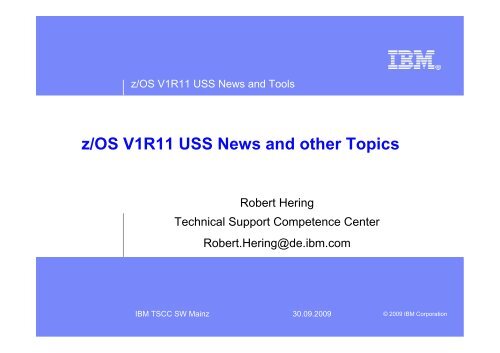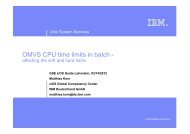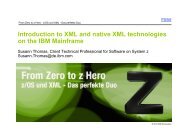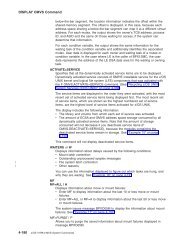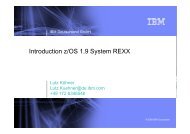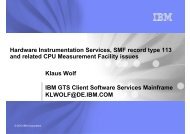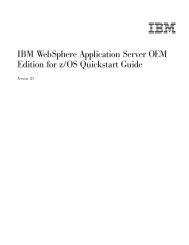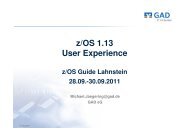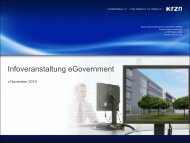Create successful ePaper yourself
Turn your PDF publications into a flip-book with our unique Google optimized e-Paper software.
z/<strong>OS</strong> <strong>V1R11</strong> <strong>USS</strong> <strong>News</strong> <strong>and</strong> Toolsz/<strong>OS</strong> <strong>V1R11</strong> <strong>USS</strong> <strong>News</strong> <strong>and</strong> <strong>other</strong> <strong>Topics</strong>Robert HeringTechnical Support Competence CenterRobert.Hering@de.ibm.comIBM TSCC SW Mainz 30.09.2009 © 2009 IBM Corporation
z/<strong>OS</strong> <strong>V1R11</strong> <strong>USS</strong> <strong>News</strong> <strong>and</strong> ToolsOverview• <strong>USS</strong> (<strong>and</strong> zFS) news in z/<strong>OS</strong> <strong>V1R11</strong>• Some comments regarding zFS in z/<strong>OS</strong> <strong>V1R11</strong>• <strong>USS</strong> remount samemode support• <strong>USS</strong> utilities• <strong>USS</strong> sysplex <strong>and</strong> zFS migration workshop2 IBM TSCC SW Mainz 30.09.2009© 2009 IBM Corporation
z/<strong>OS</strong> <strong>V1R11</strong> <strong>USS</strong> <strong>News</strong> <strong>and</strong> Tools<strong>USS</strong> (<strong>and</strong> zFS) news in z/<strong>OS</strong> <strong>V1R11</strong>• New zFS support in <strong>USS</strong> sysplex sharing– Sysplex-awareness in z/<strong>OS</strong> <strong>V1R11</strong> for R/W mounts– zFS aggregate ownership <strong>and</strong> movement• <strong>USS</strong> remount samemode support• Using the ISPF editor for OEDIT <strong>and</strong> OBROWSE• Alternate sysplex root support• <strong>USS</strong> file system enhancements– Automount, „D OMVS“, unowned file system information• User syscall trace– BPXTRACE comm<strong>and</strong>• Automatic UID <strong>and</strong> GID assignment– RACF Db needs to enabled for application identity mapping (AIM) stage 33 IBM TSCC SW Mainz 30.09.2009© 2009 IBM Corporation
z/<strong>OS</strong> <strong>V1R11</strong> <strong>USS</strong> <strong>News</strong> <strong>and</strong> ToolsNew zFS support in <strong>USS</strong> sysplex sharing• Sysplex-awareness in z/<strong>OS</strong> <strong>V1R11</strong> for R/W mounts– <strong>USS</strong> file systems mounted R/O were sysplex-aware– NFS file systems were sysplex-aware• zFS aggregate ownership <strong>and</strong> movement– <strong>USS</strong> file system owner– zFS file system owner– Automatic movement of zFS ownership may happen4 IBM TSCC SW Mainz 30.09.2009© 2009 IBM Corporation
z/<strong>OS</strong> <strong>V1R11</strong> <strong>USS</strong> <strong>News</strong> <strong>and</strong> ToolszFS sysplex-unaware for R/W mountsApplicationApplicationApplication<strong>USS</strong>File<strong>USS</strong>File<strong>USS</strong>zFSAdminzFSAdminzFSsysplex=offFFF/FFR/W5 IBM TSCC SW Mainz 30.09.2009© 2009 IBM Corporation
z/<strong>OS</strong> <strong>V1R11</strong> <strong>USS</strong> <strong>News</strong> <strong>and</strong> ToolszFS sysplex-awareness for R/W mountsApplicationApplicationApplication<strong>USS</strong><strong>USS</strong><strong>USS</strong>zFSCacheAdminFilezFSAdminFilezFSCachesysplex=onFFF/FFR/W6 IBM TSCC SW Mainz 30.09.2009© 2009 IBM Corporation
z/<strong>OS</strong> <strong>V1R11</strong> <strong>USS</strong> <strong>News</strong> <strong>and</strong> ToolszFS aggregate ownership <strong>and</strong> automatic movement• <strong>USS</strong> <strong>and</strong> zFS ownership for a zFS file system– <strong>USS</strong> owner only responsible for BRLM• <strong>USS</strong> ownership displayed using „df -v“ comm<strong>and</strong>– zFS ownership can be different• zFS ownership shown with „zfsadm lsaggr“ comm<strong>and</strong> or• new utilities „rxdowner“ <strong>and</strong> „zfsowner“ (zFS redbook)• zFS ownership moved based on file system usage– No longer need to take care of mounting at right system7 IBM TSCC SW Mainz 30.09.2009© 2009 IBM Corporation
z/<strong>OS</strong> <strong>V1R11</strong> <strong>USS</strong> <strong>News</strong> <strong>and</strong> ToolsDisplaying <strong>USS</strong> <strong>and</strong> zFS ownershipThe following comm<strong>and</strong>s show the <strong>USS</strong> <strong>and</strong> the zFS ownerfor file system HERING.TEST.ZFS.$> /usr/sbin/mount -qv test----A- OMVS.HERING.TEST.ZFS /u/hering/test$> df -v test | grep Owner | awk '{print "<strong>USS</strong> owner: "$5}'<strong>USS</strong> owner: SC70$> zfsadm lsaggr | grep OMVS.HERING.TEST.ZFS | awk '{print "zFS owner: "$2}'zFS owner: SC65$> zfsowner OMVS.HERING.TEST.ZFSzFS Owner : SC65 - Aggregate read-only=N, compat-mode=Y, sysplex-aware=Y8 IBM TSCC SW Mainz 30.09.2009© 2009 IBM Corporation
z/<strong>OS</strong> <strong>V1R11</strong> <strong>USS</strong> <strong>News</strong> <strong>and</strong> ToolsDisplaying file system ownership informationThe following comm<strong>and</strong> shows ownership related information<strong>and</strong> can be used for <strong>other</strong> PFS types like HFS as well (exceptshowing the zFS data).$> rxdowner -d testMP Directory : /u/hering/testFile System : OMVS.HERING.TEST.ZFSAggregate : OMVS.HERING.TEST.ZFSPFS Type : ZFSLocal Sysname: SC70 - File System local-client=N<strong>USS</strong> Owner : SC70 - File System read-only=NzFS Owner : SC65 - Aggregate read-only=N, compat-mode=Y, sysplex-aware=Y9 IBM TSCC SW Mainz 30.09.2009© 2009 IBM Corporation
z/<strong>OS</strong> <strong>V1R11</strong> <strong>USS</strong> <strong>News</strong> <strong>and</strong> ToolszFS sysplex state showing <strong>USS</strong> sysplex state$> zfsadm configquery -sysplex_stateIOEZ00317I The value for configuration option -sysplex_state is 2• “0” indicates that zFS is not in a <strong>USS</strong> sysplex file systemsharing environment (normal for V1R6 <strong>and</strong> prior releases<strong>and</strong> for single system configurations including monoplex<strong>and</strong> xcflocal)• “1” indicates that zFS is in a <strong>USS</strong> sysplex file systemsharing environment (normal for V1R7 to V1R10)• “2” indicates that zFS is running in a sysplex-awareenvironment (possible <strong>and</strong> new for <strong>V1R11</strong>)10 IBM TSCC SW Mainz 30.09.2009© 2009 IBM Corporation
z/<strong>OS</strong> <strong>V1R11</strong> <strong>USS</strong> <strong>News</strong> <strong>and</strong> ToolszFS admin levels• 0 - Used for zFS running on systems running at a z/<strong>OS</strong> levelprevious to z/<strong>OS</strong> V1R7• 1 - Used for zFS running on systems running at a z/<strong>OS</strong> levelV1R7 to V1R10 by default <strong>and</strong> includes the sysplexawareness of the zfsadm comm<strong>and</strong> interface• 2 - Used for zFS R11 that allows zFS V1R9 <strong>and</strong> V1R10 to runtogether with zFS <strong>V1R11</strong>• 3 - This is the zFS Admin level of <strong>V1R11</strong> - Any specificationof parameter sysplex_admin_level in <strong>V1R11</strong> is ignored aszFS in <strong>V1R11</strong> always runs at level 311 IBM TSCC SW Mainz 30.09.2009© 2009 IBM Corporation
z/<strong>OS</strong> <strong>V1R11</strong> <strong>USS</strong> <strong>News</strong> <strong>and</strong> ToolsAdmin levels in a mixed sysplex environment• zFS in V1R9 or V1R10 with sysplex_admin_level=1– Uses <strong>and</strong> follows the XCF Admin protocol among systemswith level 0 <strong>and</strong> 1 <strong>and</strong> does not initialze if a system with XCFAdmin level 3 is active in the sysplex• zFS in V1R9 or V1R10 with sysplex_admin_level=2– Uses <strong>and</strong> follows the new XCF Admin protocol amongsystems with levels 2 or 3 <strong>and</strong> does not initialze if a systemwith XCF Admin level 0 is active in the sysplex• zFS in <strong>V1R11</strong> running with sysplex_admin_level=3– By default uses <strong>and</strong> follows the new XCF Admin protocolamong systems with levels 2 or 3 <strong>and</strong> does not initialze if asystem with XCF Admin level 0 or 1 is active in the sysplex12 IBM TSCC SW Mainz 30.09.2009© 2009 IBM Corporation
z/<strong>OS</strong> <strong>V1R11</strong> <strong>USS</strong> <strong>News</strong> <strong>and</strong> ToolszFS namespaceThe zFS XCF protocol exchanges information among membersabout zFS ownership <strong>and</strong> <strong>other</strong> attributes of zFS mounted filesystems. This information, which is kept in the memory of eachzFS member, is called the zFS namespace.• The zFS namespace is validated now– on an XCF message timeout of an admin comm<strong>and</strong>– at zFS initialization– when an inconsistency is detected– when using operator comm<strong>and</strong> “F ZFS,NSVALIDATE”• Alternate possibility to display zFS ownership information– One: D GRS,RES=(SYSZIOEZ,IOEZLT.OMVS.HERING.TEST.ZFS*)– All: D GRS,RES=(SYSZIOEZ,*)13 IBM TSCC SW Mainz 30.09.2009© 2009 IBM Corporation
z/<strong>OS</strong> <strong>V1R11</strong> <strong>USS</strong> <strong>News</strong> <strong>and</strong> ToolsBenefits of the remount samemode functionSample: /usr/sbin/chmount -s /u/hering/test• A file system that is disabled for writes gets recovered withoutunmounting it.• zFS attributes for an aggregate that is active can be dynamicallychanged <strong>and</strong> pick up the current zFS system settings.• New c<strong>and</strong>idate volumes can be made available while a zFSaggregate is active.– This makes it also easier in case of adding c<strong>and</strong>idate volumes to anHFS file system.• Attention: When zFS is sysplex-aware for read-write mounted filesystems moving the aggregate to an<strong>other</strong> system <strong>and</strong> then pullingit back does no longer work.14 IBM TSCC SW Mainz 30.09.2009© 2009 IBM Corporation
z/<strong>OS</strong> <strong>V1R11</strong> <strong>USS</strong> <strong>News</strong> <strong>and</strong> ToolsHFS versus zFS performance test• We used two systems with <strong>USS</strong> sysplex filesystem sharing, SC74 <strong>and</strong> SC75• First we created two file systems on the samevolume, one of type HFS <strong>and</strong> of type zFS• Then two files of size 750MB were created <strong>and</strong>filled with data in both file systemsJCL <strong>and</strong> procedures are available in z/<strong>OS</strong> Distributed FileService zSeries File System z/<strong>OS</strong> <strong>V1R11</strong> Implementation,SG24-6580-0415 IBM TSCC SW Mainz 30.09.2009© 2009 IBM Corporation
z/<strong>OS</strong> <strong>V1R11</strong> <strong>USS</strong> <strong>News</strong> <strong>and</strong> ToolsAccessing file system files• Two jobs running in parallel on different systems, one wasaccessing large_file_1 in system SC74 <strong>and</strong> the <strong>other</strong> onelarge_file_2 in system SC75• Each job locally starts 20 processes running in parallel <strong>and</strong>doing 200 I/Os to read or write 1MB blocks• 70% of the I/Os are reads <strong>and</strong> 30% are writes• The sequence of I/Os is based on a set of predictabler<strong>and</strong>om numbers for offsets into the large files when doingan I/O access– The expression “predictable” means that all tests are usingexactly the same set of r<strong>and</strong>om numbers <strong>and</strong> make the resultsdirectly comparable16 IBM TSCC SW Mainz 30.09.2009© 2009 IBM Corporation
z/<strong>OS</strong> <strong>V1R11</strong> <strong>USS</strong> <strong>News</strong> <strong>and</strong> ToolsTest environmentSC74R11SC75R11Application<strong>USS</strong>large_file_1Application<strong>USS</strong>large_file_2Client_cachezFSUser_cacheClient_cachezFSUser_cacheR/WFFF/FFFileslarge_file_1large_file_217 IBM TSCC SW Mainz 30.09.2009© 2009 IBM Corporation
z/<strong>OS</strong> <strong>V1R11</strong> <strong>USS</strong> <strong>News</strong> <strong>and</strong> ToolsHFS <strong>and</strong> zFS performance scenariosHFS on owing systemHFS on client systemAVG sec per process MIN sec per processMAX sec per process68.44 67.24 68.93353.91 351.73 354.81zFS is sysplex-unawarezFS on owing systemzFS on client systemzFS on owing systemzFS on client systemAVG sec per process MIN sec per processMAX sec per process13.19 7.77 15.90206.80 205.23 207.62zFS is sysplex-awareAVG sec per process MIN sec per processMAX sec per process14.14 6.96 16.20128.27 124.40 136.5418 IBM TSCC SW Mainz 30.09.2009© 2009 IBM Corporation
z/<strong>OS</strong> <strong>V1R11</strong> <strong>USS</strong> <strong>News</strong> <strong>and</strong> ToolsBpxbatch optimization (RXBATCH)• Using RXBATCH to run BPXBATCH from TSO in batch modeprovides the following advantages over using BPXBATCHnative:– You can use DD name STDIN for STDIN data as desired. Youdo not <strong>and</strong> should not use DD name STDPARM <strong>and</strong> do nothave to provide the data as one long UNIX comm<strong>and</strong>.– It allows you to use BPXBATSL with parameter SH to processa login shell if you are a BPX.SUPERUSER.– This allows to work with DD names in UNIX comm<strong>and</strong>s as youstay in the same ASID.– You can code your UNIX STDIN data using your preferredcode page. This makes it easy to write the comm<strong>and</strong>s <strong>and</strong>they are much better readable.19 IBM TSCC SW Mainz 30.09.2009© 2009 IBM Corporation
z/<strong>OS</strong> <strong>V1R11</strong> <strong>USS</strong> <strong>News</strong> <strong>and</strong> ToolsBpxbatch optimization (RXBATCH)...• Using RXBATCH to run BPXBATCH from TSO in batch modeprovides the following advantages over using BPXBATCHnative:– You can use the back slash ("\") if you need to continue thecomm<strong>and</strong> on a next line even if you are using record formatFB for your JCL library.– The combination of several advantages mentioned aboveallows to use MVS data sets or members, created in yourcode page as "/bin/sh" scripts for usage as STDIN data.– Doing so <strong>and</strong> different from using the STDPARM DD nameyou can switch to <strong>other</strong> sub shells or interactive comm<strong>and</strong>processors, like using "su", "su -s" or the interactive "rexx".20 IBM TSCC SW Mainz 30.09.2009© 2009 IBM Corporation
z/<strong>OS</strong> <strong>V1R11</strong> <strong>USS</strong> <strong>News</strong> <strong>and</strong> ToolsBPXBATCH example//RXBATCH EXEC PGM=IKJEFT01,PARM=RXBATCH//SYSEXEC DD DSNAME=HERING.ZFS.REXX.EXEC,DISP=SHR//STDIN DD DATA,DLM=##pwd; idecho aaaaaaaaaaaaaaaaaaaaaaaaaaaaaaaaaaaaaaaaaaaaaaaaaaa\bbbbbbbbbbbbbbbbbbbbbbbecho "aaaaaaaaaaaaaaaaaaaaa" | catRC=$?; if [ $RC -ne 0 ]; then echo "\nRc=$RC"; exit 1; else exit 0; fi##//STDENV DD DATA,DLM=##PATH=/u/hering/bin:/usr/local/bin:/bin# --- "Pseudo" envvars -----------------------------------------------_RXBATCH_SWSU=0 < 0= no switch (default), 1= switch to SU mode_RXBATCH_LOGIN=0 < 0= no login shell, 1= login shell (default)_RXBATCH_SL=1 < 0= use BPXBATSL if in SU mode, 1= use always_RXBATCH_CP=IBM-273 < code page of STDIN data, default is IBM-1047##//STDOUT DD SYSOUT=*,LRECL=136,RECFM=VB//SYSTSIN DD DUMMY//SYSTSPRT DD DUMMY < Use "SYSOUT=*" instead in case of problems//*STDPARM DD ... < Do not add a STDPARM DD statement to this JCL21 IBM TSCC SW Mainz 30.09.2009© 2009 IBM Corporation
z/<strong>OS</strong> <strong>V1R11</strong> <strong>USS</strong> <strong>News</strong> <strong>and</strong> Tools<strong>USS</strong> User‘s default group with no GID (GETNOOVM)//* ------------------------------------------------------------------//MVSUSERS EXEC PGM=IKJEFT01,PARM='LU * NORACF OMVS'//SYSTSPRT DD DSN=&&USERS,DISP=(,PASS),UNIT=SYSDA,LRECL=136,// RECFM=VB,SPACE=(CYL,(1,1,0))//SYSTSIN DD DUMMY//* ------------------------------------------------------------------//LSTUSERS EXEC PGM=IKJEFT01,REGION=0M//SYSEXEC DD DSNAME=&SYSUID..REXX.EXEC,DISP=SHR//MVSUSERS DD DSNAME=*.MVSUSERS.SYSTSPRT,DISP=(OLD,DELETE)//SYSTSPRT DD SYSOUT=*,RECFM=VB,LRECL=136//SYSTSIN DD DATA,DLM=##profile varstorage(high)getnoovm##//* ------------------------------------------------------------------22 IBM TSCC SW Mainz 30.09.2009© 2009 IBM Corporation
z/<strong>OS</strong> <strong>V1R11</strong> <strong>USS</strong> <strong>News</strong> <strong>and</strong> ToolsRedbook information• z/<strong>OS</strong> Distributed File Service zSeries File SystemImplementation, SG24-6580– z/<strong>OS</strong> V1R10 - SG24-6580-03 (actual version)– z/<strong>OS</strong> <strong>V1R11</strong> - SG24-6580-04 (soon available as draft)• z/<strong>OS</strong> Version 1 Release 11 Implementation, SG24-7605– Soon available as draft• Available from IBM Redbooks– http://www.redbooks.ibm.com/23 IBM TSCC SW Mainz 30.09.2009© 2009 IBM Corporation
z/<strong>OS</strong> <strong>V1R11</strong> <strong>USS</strong> <strong>News</strong> <strong>and</strong> Tools<strong>USS</strong> Sysplex <strong>and</strong> zFS Migration Workshop• <strong>USS</strong> Sysplex File System Sharing– <strong>USS</strong> Sysplex Environment– zFS– Debugging• zFS Migration <strong>and</strong> Backup– Overview of different possibilities <strong>and</strong> migration tasks– HFS to zFS Migration using the st<strong>and</strong>ard migration tool BPXWH2Z• available with z/<strong>OS</strong> in SYS1.SBPXEXEC– HFS to zFS Migration using the MIGRTOOL• described in Redaper HFS to zFS Migration Tool, REDP-4328– Migration of the Sysplex Root• available with z/<strong>OS</strong> V1R10 via comm<strong>and</strong> F OMVS,NEWROOT– Migration (<strong>and</strong> Backup) zFS• Backup possibities• Copying from SMS to Non-SMS• Copying between zFS with <strong>and</strong> without extended addressability• Workshop ZOFSE0DE– Week 50 2009; Mo, Dec 07 – Fr, Dec 1124 IBM TSCC SW Mainz 30.09.2009© 2009 IBM Corporation
z/<strong>OS</strong> <strong>V1R11</strong> <strong>USS</strong> <strong>News</strong> <strong>and</strong> ToolsLE Workshop „on dem<strong>and</strong>“• LE Concepts• Runtime Options• Storage– HANC, HEAP• Getting Dumps– Slip, Trace, CEEDUMP <strong>and</strong> SVC Dump• Dump Debugging (Theory <strong>and</strong> H<strong>and</strong>s On)– Unformatted Dump (SVC Dump), Formatted Dump (CEEDUMP),– TraceBack, <strong>USS</strong> <strong>and</strong> CICS• What's new in z<strong>OS</strong> LE?25 IBM TSCC SW Mainz 30.09.2009© 2009 IBM Corporation
z/<strong>OS</strong> <strong>V1R11</strong> <strong>USS</strong> <strong>News</strong> <strong>and</strong> ToolsWorkshop Portfolio des TECCWir bietenIn den folgenden Themenbereichen• auf Ihre Bedürfnisse angepasste Workshops• Sie bestimmen die Themen und die Tiefe derWorkshops und somit die Dauer der Schulung• in Mainz• oder in ihrem HauseUnsere Kompetenz• Wir schulen die Kundendiensttechniker und denSupport aus Deutschl<strong>and</strong> und Europa• Wir organisieren Workshops ... on dem<strong>and</strong>• Wir bilden die Mitarbeiter in den technischen Skillsaus• Wir pflegen ein enge Zusammenarbeit mit denKollegen vom HW & SW-Support• Wir haben Zugriff auf die weltweit größte KnowledgeDatabase• Wir arbeiten zusammen mit den weltweiten IBM HW &SW EntwicklunglaborsHardware•BladeCenter•RMSS•SAN•System Storage EnterpriseDisk•System p•System xOn Dem<strong>and</strong> WorkshopKundenreferenz• BusinesspartnerSystem P - Support undTechniker TrainingSoftware•Microsoft Windows•z/VM•DB2 for z/<strong>OS</strong>•z/<strong>OS</strong> – Networking•IPv6•z/<strong>OS</strong>On Dem<strong>and</strong> WorkshopKundenreferenz• Bank in Frankfurtz/<strong>OS</strong> R9 + R10 Update +SYSREXX• Bank in Frankfurtz/<strong>OS</strong> Advanced ProblemDetermination - Websphere, LE,<strong>USS</strong>, JAVARudolf Karberkarber@de.ibm.com06131 / 84 531606461 / 989032• Fordern Sie uns!• Fragen Sie auch nach speziellen Ausbildungen!• Nutzen Sie unser unser Lab-Environment als Kunden Testumgebung26 IBM TSCC SW Mainz 30.09.2009© 2009 IBM Corporation


